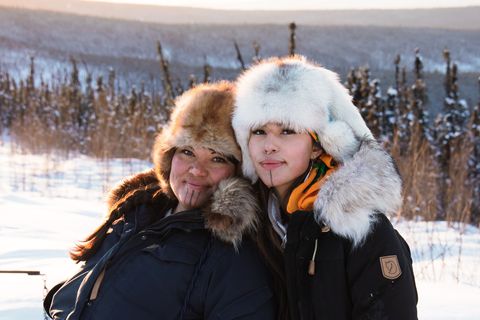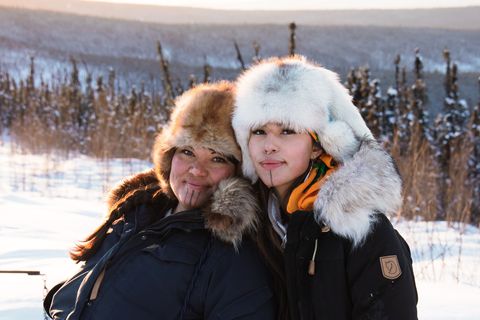Quannah Chasinghorse Straddles Two Worlds
Most people know Quannah Chasinghorse for her command of runways and iconic Met Gala looks—“but she’s also a hunter,” her mother, Jody Potts-Joseph, wants you to know. She’s speaking beside Quannah at an event before the Tribeca Film Festival premiere of a short film that portrays her daughter’s dexterity in navigating life as a high fashion model and an Indigneous land protector. “She knows how to clean a fish. She knows how to be on her land, build a campfire, chop wood, and she knows how to make fry bread, too.”
That’s the premise of the aptly-named Walking Two Worlds, the 29-minute short film directed by journalist and climate activist Maia Wikler, and supported by The North Face. Shot over a period of three years, the film highlights the multi-generational effort behind Chasinghorse’s activism to protect her Han Gwich’in ancestral homeland, the Arctic National Wildlife Refuge in northern Alaska, from oil drilling and the hastening effects of climate change. Wikler met Chasinghorse on Capitol Hill, where the two were both lobbying to stop oil drilling in the Arctic Refuge in 2019.
Through Chasinghorse, Potts-Joseph, and Potts-Joseph’s mother, Adeline Potts, the film shows viewers what it means to live off the land, as Indigenous peoples have for millenia. The three generations of women are seen mushing their dog team, subsistence fishing along the Yukon River, caribou hunting in the expansive wilderness, and sewing hide to make clothing. “That’s how I was raised,” Adeline Potts says in the film. “We used dog teams to get around. Fishing. Hunting. That was just a part of our life. Jody picked it up, that’s how we raised her, and therefore Quannah is doing it, too.”
Walking Two Worlds was originally intended to come out ahead of the 2020 election, when the fate of the Arctic Wildlife Refuge hung in the balance: Former President Trump was chartering a course to open up a portion of the Refuge for oil and gas drilling, while Democratic nominee Joe Biden was campaigning on the premise of permanent protection. But with the setback of a worldwide pandemic, and Chasinghorse’s speedy rise in the modeling industry, beginning when a Calvin Klein scouting agent discovered her in fall of 2020 through her advocacy work, the creative team behind the film re-focused their narrative. “We eventually reached this place where it was like, Indigenous representation is part of climate justice, and the sovereignty and reclamation of narratives,” Wikler says at the event.
Native Americans and Alaska Natives have largely been left out of climate conversations about their land and face barriers to representation at almost every level. Despite accounting for nearly half of all the 574 federally recognized tribes in the United States, some Alaska Natives were unable to vote until as recently as 1970 due to English literacy requirements and a lack of polling locations in remote villages. Today, a legacy of discrimination persists for Native communities. Factors like geographic isolation, a lack of comprehensive translations in Native languages, digital divides, and state-specific voting provisions that disproportionately impact minority voters all contribute to a low representation of Natives in decision-making positions. Chasinghorse’s own grandparents weren’t able to vote, a reality that inspired her activism to encourage Native voting as “one way that we can get our voice, our opinions, and our values recognized,” she says.
Another way, for Quannah, has been through modeling. Since her rise to fame in late 2020 with the Calvin Klein “One Future” voting campaign, Chasinghorse has signed with IMG Models and appeared on the cover of several major fashion magazines, including ELLE. She has twice been invited to the Met Gala, and became the first Indigenous woman to walk for Chanel.
With every opportunity, she has shown up with more than just her face—she brings her voice. Not only does the young Han Gwich’in and Oglala Lakota model dispel myths about contemporary Indigenous lifestyles (“No, we do not live in igloos,” Chasinghorse says in her Calvin Klein campaign), she also brings awareness to issues that disproportionately impact Indigenous peoples, such as high rates of Missing and Murdered Indigenous Women. For example, after a photoshoot, the Dutch high-fashion photographer duo Inez van Lamsweerde and Vinoodh Matadin who worked with Chasinghorse wrote in a shared Instagram caption that meeting Quannah taught them “we all know Nothing about how Real Native American people live.”
Chasinghorse always wanted to be a model, she says in Walking Two Worlds over a clip of herself at five-years-old, pig-tailed and singing into a spoon. But she didn’t see her distinctly Lakota features reflected back at her on the cover of magazines. “I didn’t think the industry was ready for Indigenous representation like me, meaning a Native woman with facial tattoos,” Chasinghorse, 20, says in the film. She carries several Yidįįłtoo, traditional Alaska Native facial tattoos, given to her by her mother. “Wherever I walk into these spaces, I want them to know, if you’re going to work with me, work with all of me. Don’t try to cover up my tattoos, don’t try to cut my hair, don’t try to dye my hair. Work with me as me.”
Near the end of the film, we see Chasinghorse has moved from her home in Alaska to a “brand-spankin’-new” apartment in Los Angeles closer to career opportunities. Tears well up in her eyes as she talks about adjusting to life in a city and all the things she’s missing back home: the land, her family, hunting season. Her family’s fish camp nearly burned in a massive lightning-caused wildfire in June of 2020, an increasingly common occurrence in Alaska as summers get hotter and dryer. “Everything is under threat, and if I am not going to be able to go back home within the next few years, those things might be gone,” Chansinghorse said in a clip Wikler contextualized as their final, four-hour interview. “Was it worth it?” she asks of choosing to live away from her land to make it as a model and represent her community.
If you were to ask the audience, who erupted into cheers as Walking Two Worlds darkened to a close, they likely would have said yes. Chasinghorse’s 400,000 person following on Instagram—many of whom are Native girls growing up in a world where they find themselves in Quannah’s features in a glossy magazine—might say yes, too. In the audience, the daughter of Secretary of the Interior Deb Haaland—the nation’s first Native cabinet member from the Laguna Pueblo—Somáh Haaland, appeared to be saying yes as she waited to congratulate Quannah at the close of the premiere. Haaland told ELLE they relate to the film on many levels: as a Native kid who chose to leave their community in New Mexico to pursue a career in acting, as someone who is finding it hard to break into a specific industry not designed for them, and as someone who has had to navigate being in the public eye. “Many Indigenous people will relate to this narrative of having to exist in multiple worlds at once,” Haaland says. “I also think Quannah is an important role model for Indigenous youth who are so often told that they need to leave parts of themselves behind in order to be accepted into certain spaces.”
Chasinghorse herself appeared to answer her own question with the ear-to-ear smile on her face after the premiere. She wore a sleek black strapless gown by Native fashion brand Red Berry Woman, Indigenized under the bust with hand beading and pennies. “Even though walking in two worlds is hard, it is possible,” Quannah says, surrounded by a theater half full of Indigenous friends, family, and strangers who showed up to celebrate her, and also themselves. “We belong in these spaces, and we deserve to be here.”
This content is created and maintained by a third party, and imported onto this page to help users provide their email addresses. You may be able to find more information about this and similar content at piano.io




